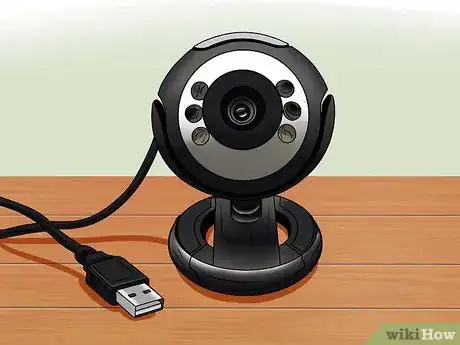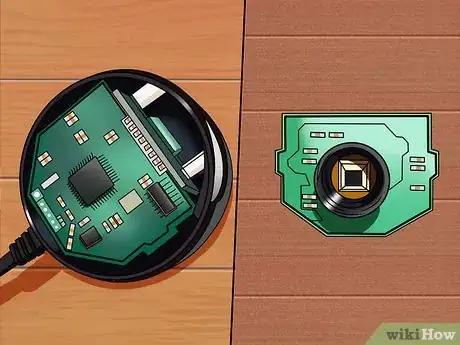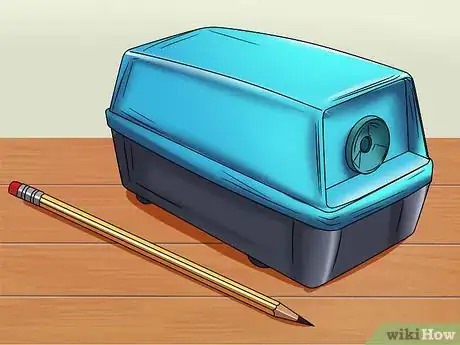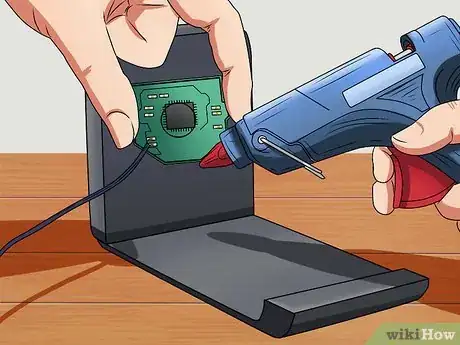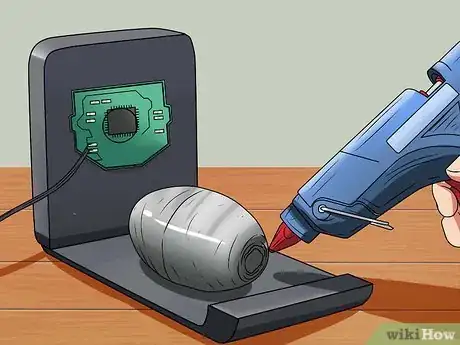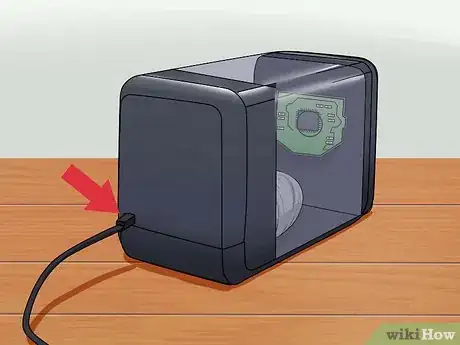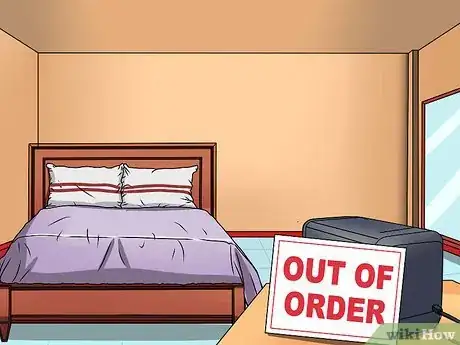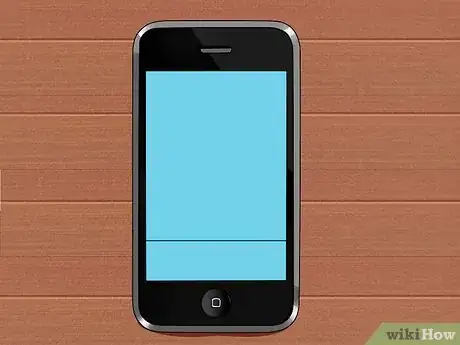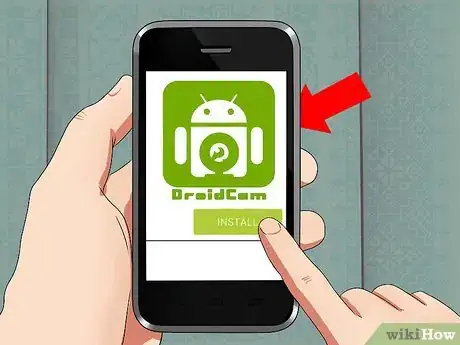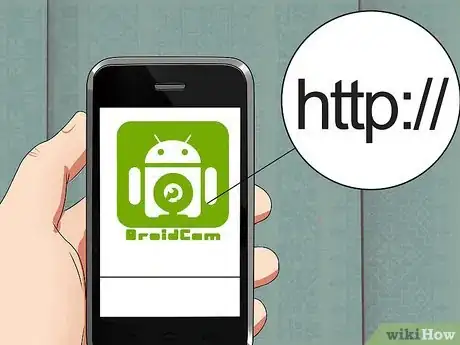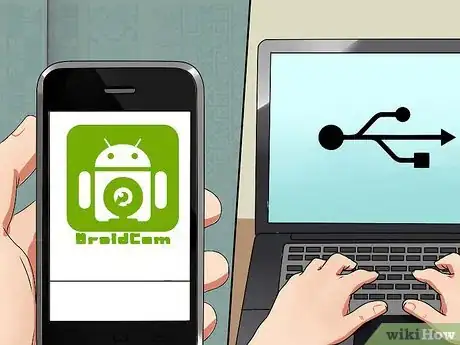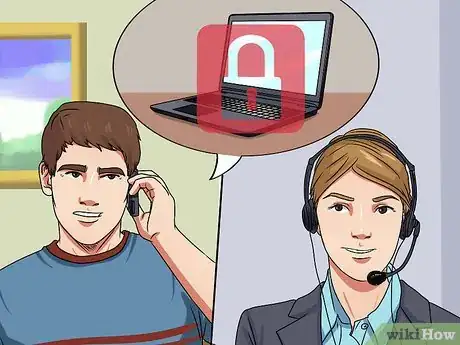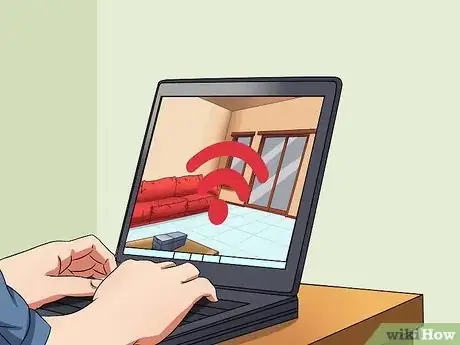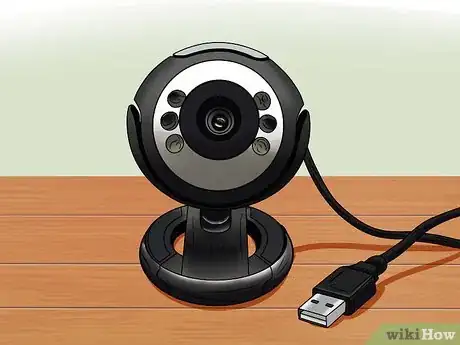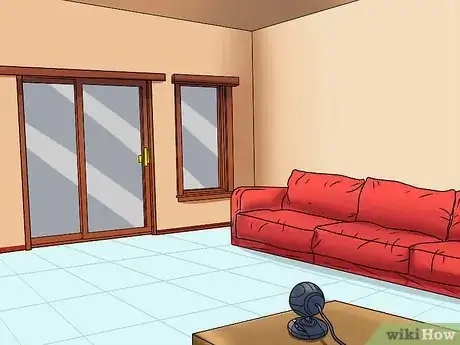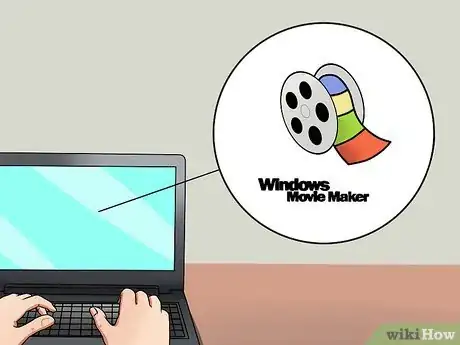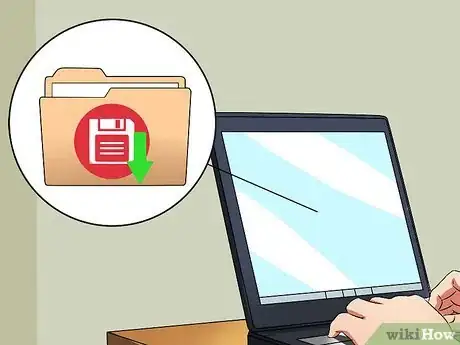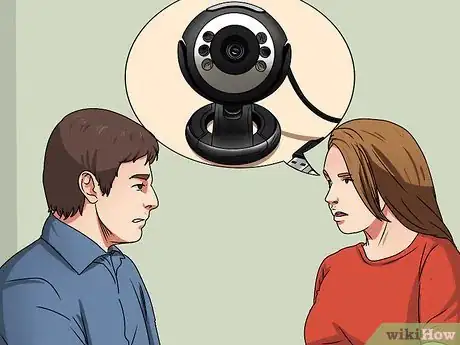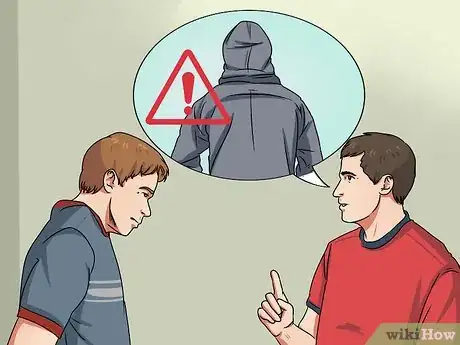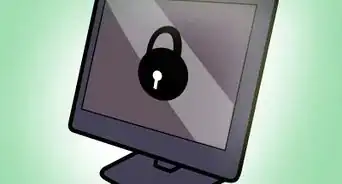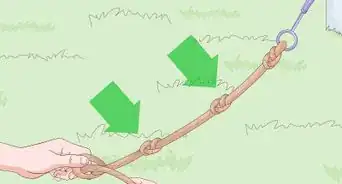wikiHow is a “wiki,” similar to Wikipedia, which means that many of our articles are co-written by multiple authors. To create this article, 29 people, some anonymous, worked to edit and improve it over time.
There are 7 references cited in this article, which can be found at the bottom of the page.
This article has been viewed 777,251 times.
Learn more...
Someone's been snooping around in your things, but you don't know how to prove it. Whether the culprit is a friend, a family member, a coworker, or a mortal enemy: a hidden camera can help you collect the evidence you need to confront the culprit and put an end to their sneaking ways.
Steps
Hiding a Webcam Inside a Household Object
-
1Obtain a cheap webcam. You should be able to find a suitable model for less than $10. Run a web search for "cheap webcam".
- Pick a basic, compact webcam. The camera must be small enough to escape detection. You may choose to hide it inside a household object like a pencil sharpener or a tissue box; bear this in mind as you're choosing a camera.
- If you want to set up the camera as soon as possible, you should be able to find a webcam at a large electronics store (BestBuy, Circuit City, etc.) Ask for their cheapest, smallest model.
- If you're trying to capture a serious crime, consider installing a professional-grade security camera.[1] Homemade hidden cameras are fun, and they will work in a pinch--but the video quality will be much higher on a more expensive setup.
-
2Remove the outer shell of the webcam. You should be able to see the circuit board upon which the lens is mounted. This will make the camera considerably smaller, and thus much easier to hide.[2]Advertisement
-
3Pick your hiding spot. Get creative! Your camera will not be so easily spotted if you hide it inside a nondescript household object. Make sure to use something that you would usually keep in your room or office; an out-of-place object may arouse suspicion.[3]
- For example: Find an old electric pencil sharpener that no-one is using. You can take out the insides and point the camera out of the pencil-sharpening hole. Unscrew the shell and remove the motor, the wires, and the power cord from the inside. Make sure that the sharpener is unplugged!
- Try using a cardboard shoe-box or tissue box. Cut a small hole in the side of the box so that the camera can "see" out. Make sure that the hole isn't too big: you don't want anyone to get suspicious!
- Consider using a shopping bag or gift bag. Again, cut a small hole in the side of the bag. The hole will be harder to spot if the outside of the bag is textured or patterned. A black or dark-colored bag will make the hole even harder to notice.
- Consider hiding the camera in the leaves of a potted plant or deep in the recesses of a bookshelf--anywhere that someone will be unlikely to look closely. Make sure that the camera lens is pointing where you need it to point.
-
4Mount the camera inside the object. Point the lens facing out of the hole in the object. Make sure that the camera fits, and that it doesn't look obvious.
- If you think that the object will be moved around at all, consider using superglue to hold the camera in place. Glue the outer rim of the camera lens such that it's facing out of the hole. Be careful to keep glue away from the lens glass--this will blur the video quality, and it is very difficult to remove.
-
5Tape or glue fishing weights inside the shell to keep the object from seeming unusually light. This is most important when hiding a camera inside machines--pencil sharpeners, clocks, and the like--that usually feel heavy.
- If you don't have fishing weights, any heavy, flat piece of metal should do the trick. Be careful when handling jagged metal.
-
6Thread the USB cord (the cable that connects the webcam to the computer) through the back of the hiding spot. You may need to place the hidden camera near your computer if the cable isn't very long.
- Cover the USB cord with something. Loose papers or a jacket will do--but make it look natural. If a "pencil sharpener" is obviously connected to your computer, the snooper may become suspicious.
-
7If you hide your camera inside an appliance, consider taping up an "Out of Order" sign so that no-one tries to use it. If someone tries to turn it on, they might find your camera.
- Keep in mind, however, that an "Out of Order" sign may call attention to the object. People may be more likely to ignore the "appliance" if you don't label it--especially if you place it out of the way.[4]
-
8Point your camera toward the scene of the crime. Think of yourself as a film director setting up a scene: think about what you are trying to prove with the footage, and think about how important it is that you can see the culprit's face.
- If you just want someone to stay out of your space--say, a sibling sneaking into your room--point the camera toward the door so that you can catch them coming in.
- If you are trying to stop someone from messing with a specific thing--say, you want to keep a sibling from taking your clothes, or a coworker from stealing your stapler--point the camera toward that thing so that you can see what they do.
- If you want to capture several different crimes, set the camera back far enough that the lens catches a wide swath of the room. Consider setting up two cameras, though be sure to vary your hiding spots.
Using Your Phone as a Hidden Camera
-
1Acquire a smartphone. Any old Android, iPhone, or internet-capable iPod should do the trick--anything that can run an app and access the internet.
- Bear in mind that the phone itself will be taking the footage. Thus, you won't be able to use the phone for anything else while you're filming. It's best to use a phone that you don't need on a regular basis; you may be able to acquire a used phone from a friend or from a used-phone retailer.
- Make sure that you have an AC power charger for the phone. It will be very energy-intensive to record a constant video stream, and you'll need to keep the phone charging.
-
2Install a free webcam app.[5] You should be able to find a suitable program from your phone using the App Store or the Google Play Store. Search for "webcam app".
- Look for apps like IP Webcam, MobileWebCam, DroidCam, or iCam. Read reviews before you download any app, and make sure that you're downloading something safe.
- Many of these apps are free, and the developers make their money from ads. Don't worry about paying for a more expensive app; a free program should be sufficient.
- You will need to give the webcam app full control of your phone's camera, meaning that no other app can use the camera while the webcam app is running. This will not harm your phone or its camera.
-
3Note the URL for your webcam app. You will need this to link the phone to your computer.
-
4Connect the phone to your PC. Make sure that the two devices are connected to the same wireless network. You will be able to remotely watch and record the feed. Use any video player with stream compatibility, such as VLC or Windows Media Player.
- If you are using VLC, click "Open Network Stream" on the "Media" menu, and enter the URL that shows up on the phone's webcam app. Once you enter this URL, you should be given the option to connect to the phone's camera.
- Free programs like VLC and Windows Media Player are great for watching a webcam stream through your computer, but you won't be able to record high-quality footage. If you're really serious about surveillance, consider looking into pricier webcam studio software.
-
5Set up the camera. The phone will need to sit next to a charger, so plan accordingly. Point the phone-camera lens toward the area that you want to film, and place the phone such that it won't fall flat.
- Leaning the phone casually against a wall or a stack of books may suffice, especially if the phone is laying on its lengthwise side.
- Consider hiding the phone inside of a household object. See the "Hiding a Webcam Inside a Household Object" section.
- Turn off the sound and the vibrate feature on the phone, especially if the phone is enabled to take calls and texts. A loud ringtone at the wrong moment could ruin your entire plan.
-
6Secure your network. Consider setting a secure, password-protected wireless network. If you set this up on an unprotected or public network, anyone who can pick up the network will be able to see your footage.
- Ask your internet service provider about secure network options. If you are paying for wireless internet, you should be able to set up a password from your router.
-
7Watch the stream from your computer. If you need to leave the house, you can connect to a public wifi network at a coffee shop, a restaurant, or a library.
Taking Footage
-
1Be aware of the law. In the U.S., it is generally legal to use a hidden camera to record footage without a person's consent--provided that you are filming in public or within your own home. Many states have passed laws against filming people in spaces where they have a reasonable expectation of privacy, such as bathrooms or personal bedrooms.[6]
- It is generally legal to use a hidden camera in the workplace, as long your filming pertains to a business concern. Don't film someone at work without their consent in order to settle a personal dispute--unless you're ready to risk legal consequences.[7]
- Laws vary between states and countries. Research the laws for your area before you record audio or video of anyone without their express consent.
- If you are planning to distribute the footage, sell the footage, or use it in court, then it is extremely important that you follow the law. If you are only planning to use the footage for personal entertainment purposes, you may not need to worry so much.
-
2Download a webcam recording program. Run a web search for "free webcam recording program" and install the software onto your computer.
- You may be able to use Windows Movie Maker or iVideo, if these are already installed on your computer. Search the Start menu (bottom left-hand corner of the Windows desktop) to figure out whether you have a program installed.
-
3Hook the USB cord up to your computer. When you leave the room, or when you are ready to start recording, boot up the recording software and click "Record".
- Cover up the USB cord with something so that it isn't obviously running to the hidden camera. Books, papers, or a jacket will do--anything that looks natural.
-
4If you already own a webcam, consider simply using your existing camera to take the footage. Be subtle; only do this if you typically keep a webcam next to your computer.
- Keep in mind that while this may be a more straightforward approach, the snooper may be more suspicious if they notice a camera point at them--even if they don't think that it's turned on.
- Be sure to turn off, cover, or disable the LED light that shows that your webcam is running. The "recording" light may tip off a snooper that they are being filmed.
-
5Make sure to turn off or darken your screen. If the screen is open and the snooper can see the webcam feed, they will know that they are being recorded. You have to be sneaky to catch a sneak.
- If you own a desktop computer, you should be able to turn off the monitor and leave the computer tower running.
- If you own a laptop, you may be able to put the screen to sleep while the recording program runs. You may also consider folding the screen down until the laptop is almost--but not quite--closed. The computer will look like it's off, but it will still be running.
-
6Keep recording until you get the footage you need. Leave the camera running when you think that it will capture what it needs to capture. If you're not sure, leave it on as often as possible.
- If time goes on and you don't capture anything incriminating, reconsider the situation. Was the snooping a one-time thing? Has the snooper found a way to sneak around your camera?
Presenting the Evidence
-
1Use a video editing program to isolate the clip of the crime. Your computer may be pre-installed with a default program (Windows Movie Maker or iVideo); if not, you should be able to download free video editing software from the Internet.
- Make sure that the clip shows exactly what you need to prove your point. Whether you caught a sibling stealing from your room or a coworker stealing from your cubicle: the clip should start a few seconds before the crime and end a few seconds afterward.
- Save the relevant footage in a new video file, but do not delete the extra footage just yet. Sometimes evidence appears where we least expect it. You may find something interesting when you review the extra footage.
-
2Save an extra copy of the footage in a separate folder. If you plan to use this video to make any sort of legal or professional case, it is important to protect your evidence.
- Consider emailing yourself a copy of the file. Even if someone goes to drastic measures to find and delete the footage from your computer, you will have a remote copy that you can download onto any computer with an internet connection.
- For the same reason: consider saving the footage onto a USB flash drive. Keep the drive in a safe place.
-
3Confront the snooper. Be tactful. Tell them that you know that they were sneaking around in your things, and ask them them not to do so again.
- You do not need to bring up the hidden camera immediately. It may come in handy later on, if they continue to sneak around after you've asked them to stop. If they own up to their snooping ways when you confront them, then you don't need to show them the evidence.
- If the snooper knows that you've hidden a camera somewhere, and knows where you've hidden it, they may find a way to sneak around it. Don't reveal your trump card right away.
-
4Forgive, but don't forget. Some people don't learn the first time they're caught. Be aware that depending on who you're dealing with, merely catching the snooper in the act once may not stop them from snooping in the future.
- Consider leaving the camera running when you suspect that the snooper might strike again. It never hurts to be sure.
- If the problem continues, tell an authority figure. If you're dealing with a sneaky sibling, tell your parents. If you're dealing with a sneaky coworker, consider notifying your supervisor. If the snooping is of a criminal nature, consider contacting the police.
Community Q&A
-
QuestionCan a camera be hidden on a person?
 Community AnswerYes, you can buy special glasses that have cameras in them at spy shops or online.
Community AnswerYes, you can buy special glasses that have cameras in them at spy shops or online. -
QuestionCan that be used in a classroom?
 Community AnswerWebcams can be used wherever they are needed. Just be careful not to get caught!
Community AnswerWebcams can be used wherever they are needed. Just be careful not to get caught! -
QuestionWhat do I do if I get caught by the camera each time?
 Community AnswerEither stop sneaking around, or map the area of where the camera can see, and when the time is right sneak around it.
Community AnswerEither stop sneaking around, or map the area of where the camera can see, and when the time is right sneak around it.
Warnings
- When you reveal the evidence, just tell your parents and sibling that you left an ordinary video camcorder running in the room. Do not reveal your secret weapon.⧼thumbs_response⧽
- Be aware that it is generally illegal to film people without their consent in spaces where they can reasonably expect privacy such as bathrooms or personal bedrooms.⧼thumbs_response⧽
References
- ↑ http://www.cnet.com/uk/news/security-camera-roundup/
- ↑ http://www.ugolog.com/pages/build-a-spy-camera
- ↑ http://www.oddee.com/item_97052.aspx
- ↑ http://www.brickhousesecurity.com/category/hidden+cameras/how+to+make+a+hidden+camera.do
- ↑ http://www.digitaltrends.com/mobile/how-to-turn-android-iphone-into-spy-camera-or-baby-monitor/
- ↑ http://www.brickhousesecurity.com/category/hidden+cameras/hidden+spy+camera+laws.do
- ↑ http://employment.findlaw.com/workplace-privacy/are-hidden-cameras-at-work-legal-.html
About This Article
To make a hidden camera, remove the outer shell of a compact webcam and hide the cam in a stationary object in the area where you want to record. If you aren't able to use a wireless webcam, make sure that the webcam's USB cord is hidden and plugged into your computer. You can also download a free webcam app onto your smartphone and link the phone to your computer. You can then watch the footage remotely on your PC using a video player with stream compatibility. For tips on setting up your camera to capture the best video, read on!
